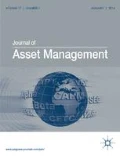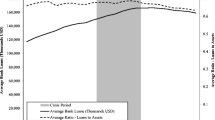Abstract
Banking sector loans are the principal source of capital for small and medium business ventures in India, comprising firms that are not large enough to be registered with stock exchanges. Non-performing assets (NPAs) are an important measure of the success of these businesses, as well as of their levels of discretion in carrying out their commercial activities conditional on their role in developing India's entrepreneurship outside the stock markets. In this article we analyze certain properties of NPAs in Indian Banks over the 1990s, when liberalization was introduced by opening up a significant portion of the public sector, allowing private banks to do business. We arrive at three conclusions for emerging India's banking sector. First, NPAs (as a ratio of loans and advances) are significantly sticky over time. Second, larger NPAs are associated with larger advances and vice-versa. Third, NPAs do not seem to have spiraled out of control over the 1990s. A simple cointegration test is carried out and a set of dynamic graphs, using notions of ‘fibration’, is presented to support the results.







Similar content being viewed by others
References
Allen, F. and Gale, D. (2000) Financial contagion. Journal of Political Economy 108: 1–33.
Bagchi, A.K. (1997) History of the State Bank of India Vol.2: The Era of the Presidency Banks 1876–1920. New Delhi, India: Sage University Press.
Geanakoplos, J. and Polemarchakis, H. (1986) Existence, regularity, and constrained suboptimality of competitive allocations when markets are incomplete. In: W. Heller, R. Starr and D. Starrett (eds.) Essays in Honor of Kenneth Arrow, Vol. 3, Cambridge: Cambridge University Press.
Goldstein, M. and Turner, P. (1996) Banking crises in emerging economies: Origins and policy options. Basle: Bank for International Settlements, Monetary and Economic Department. BIS Economic Papers, p. 46, http://www.bis.org/publ/econ46.pdf.
Granger, C.W.J. and Newbold, P. (1977) Forecasting Economic Time Series. New York: Academic Press.
Gurley, J.G. and Shaw, E.S. (1960) Money in the Theory of Finance. Washington DC: Brookings Institution.
Kaminsky, G.L. and Reinhart, C.M. (1996) Banking and Balance of Payment Crisis: Models and Evidence. Washington DC: Board of Governors of the Federal Reserve. Working Paper.
Kaminsky, G.L. and Reinhart, C.M. (1999) Bank lending and Contagion: Evidence from the Asian Crises, Working Paper.
Kiyotaki, N. and Moore, J. (1997) Credit cycles. Journal of Political Economy 105: 211–248.
Mallick, S.K. (1993) Bounded rationality & Arrow-Debreu economies. Unpublished PhD dissertation, Department of Economics, New York University.
Mallick, S.K. (2006) Bounded Rationality & Incomplete Asset Markets, Economic Theory Monograph. New York: Sringer Verlag, submitted.
Mallick, S.K. (2007) Incomplete asset markets and imperfect competition in asset markets. Quantitative Finance, submitted.
Rao, M.J.M. (2000) Estimating time-varying parameters in linear regression models using a two-part decomposition of the optimal control formulation. Sankhya Series B(62): 433–447.
Sarkar, A., Roy, K.K., Mallick, S.K., Duttachaudhuri, T. and Chakrabarti, A. (2001) Financial Fragility, Asset Bubbles, Capital Structure and the Real Rate of Growth: A Study of the Indian Economy, 1970–2000. New Delhi, India: Planning Commission, Government of India.
Stiglitz, J. and Weiss, A. (1981) Credit rationing in markets with imperfect information. American Economic Review 71 (3): 393–410.
Acknowledgements
The authors thank the Planning Commission of India for financial support. This article has benefited from comments by Kenneth West, Frank Hahn, Darrell Duffie, A. Zaman, M.Gittleman, A. Vinay Kumar, and a referee and participants at an International Conference on Entrepreneurial & Small Business Finance 2006 at IIM Lucknow. The usual disclaimer applies.
Author information
Authors and Affiliations
Corresponding author
Rights and permissions
About this article
Cite this article
Mallick, S., Sarkar, A., Roy, K. et al. Dynamics of emerging India's banking sector assets: A simple model. J Asset Manag 11, 62–70 (2010). https://doi.org/10.1057/jam.2010.1
Received:
Revised:
Published:
Issue Date:
DOI: https://doi.org/10.1057/jam.2010.1




